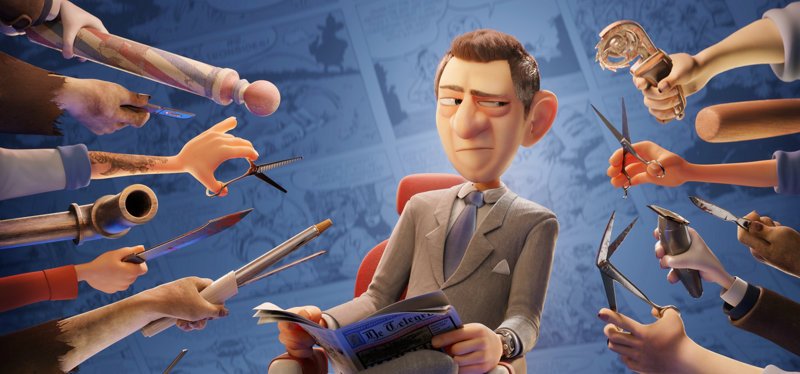The Blender Institute has released a three-minute teaser for a full-length animated feature based on the Agent 327 comic series by Dutch cartoonist Martin Lodewijk. The short was co-directed by Hjalti Hjalmarsson and former Pixar artist Colin Levy. Watch it on Agent 327’s website.
For the Agent 327 movie itself, the Blender Institute is establishing Blender Animation Studio, a separate department devoted to feature animation, for which it aims to recruit a team of 80 artists and developers from its international network. To help raise the film’s proposed budget of €14 million, the Institute has signed with leading talent agency WME, which represents Hollywood directors Martin Scorsese, Ridley Scott and Michael Bay.
“Blender Animation Studio is devoted to producing feature animation with world-class visuals and storytelling, created entirely in free and open-source software”, says founder and producer Ton Roosendaal. “We’ve proved that Blender can create stunning short films. Now we aim to create stunning features, while building and sharing a free software production pipeline.”
Although the Agent 327 movie isn’t the first film to be created in Blender – a distinction that belongs to 2010 Argentine animated comedy Plumíferos – it will be by far the largest and most ambitious, and one that the Blender Institute hopes will revolutionize feature animation.
“As an independent studio, we’re in the unique position of being in complete control of the tools we use in production”, says Roosendaal. “That’s a luxury enjoyed only by the world’s largest animation facilities. We intend to create movies that redefine the concept of independent animated feature production.”
Building an open-source feature animation pipeline
As with all of the Institute’s open movies, technical development on the project feeds back into public builds of Blender. In the case of Operation Barbershop, the work done on Cycles, the software’s physically based render engine – which now renders scenes with hair and motion blur 10 times faster – was rolled out in Blender 2.78b in February. Work on Blender’s dependency graph, which controls the way a character rig acts upon the geometry of the model, will follow in the upcoming Blender 2.8. “For users, it’s going to mean much better performance, enabling much more complex animation set-ups than are possible now,” says Siddi.
Other development work focused on the Blender Institute’s open-source pipeline tools: render manager Flamenco and production-tracking system Attract. “The pipeline for making shorts in Blender is already super-solid, but we wanted to build a workflow that could be used on a feature film,” says Siddi. “Operation Barbershop was great for identifying areas for improvement, like the way we manage asset libraries.”
Translating a 1970s comic icon into 3D
A key artistic challenge on the project was translating the stylized look of the original 1970s comics into 3D. “Agent 327 doesn’t fit the American design template for animated characters”, says Blender Institute pipeline TD Francesco Siddi. “He has a gigantic nose, gigantic ears, and bags under his eyes. How many Disney movies do you see with characters like that?”
For the work, the Institute’s modeling and design artists, led by Blender veteran Andy Goralczyk, carried out a series of look development tests. Concept designs were created in open-source 2D painting software Krita, while test models were created in Blender itself, and textured in GIMP.
Another issue was balancing action and storytelling. Operation Barbershop isn’t a conventional animated short, but a proof of concept for a movie. It’s designed to introduce Agent 327’s universe, and to leave the viewer wanting more. To achieve the right mix of narrative and exposition, Colin Levy and co-director and lead animator Hjalti Hjálmarsson ping-ponged ideas off one another, mixing animated storyboards, live action, and 3D previs.
Find out more on Agent 327’s website.












Great!, go Blender!
Juang3d is going to be really happy 🙂
You bet it! hehehe
I hope they finally get the funds for the feature film, this will benefit blender A LOT, each time BI makes a movie Blender evolves a lot 🙂
Cheers!
Yeah, we’ve been tracking Blender’s developement for years now, only since we started considering switching to it or Houdini did we really look at it and it’s ecosystem, turns out it has a plethora of really powerfull add-ons, i’ts core package is really capable. Once you get a feel for the dev branches and roadmap you realize how nice it is to know where the package is going.
We’re still looking at Houdini nevertheless we’ve started implementing Blender.
My most sincere congratulations to blender institute and Ton. After All this years, finally, they made it. By giving the tool to everybody they manage to
be able to create a film, a studio and an entire pipeline good enough to finish a proper cartoon film. Analysing the big picture from the beginning to now, this is impresive.
watching it over and over, totally amazing work! congrats Blender Institude
Where is Olga Lawina?
@Animatect We’re very happy here, too. What Ton & team have been doing is great for all artists, and for art itself. History of art is filled with greatly talented artists who struggled financially. Blender is allowing many people to produce excellent art that they would not have been able to otherwise.
Yeah, I’m so glad to see so much going on for them, at our studio we collaborate closely with a national University, just last week we were talking with the coordinator of the animation program and he was telling us that one of the main problems they were facing was that students were taught vray and Max at school but refused to use it at home, almost all of them used blender for homework and personal projects, the new generations have an open source- no cracking culture embedded, and blender seems to cater perfectly to their demographic.
When I started my career in Toronto almost 10 yrs ago, we used lightwave at the studio, even then I remember my boss telling me he couldn’t believe that a free software had so many things a paying one lacked.
That was then, now the software has flourished amazingly and Ton and the team deserve the respect of the whole industry for what they have accomplished.
As for Blender, I think it’s about time it gets the place it rightfully deserves among the leaders of the industry.
Just as a final thought, in a time where the industry behemoth is permeating the field with it’s draconian ways, an incorruptible option is not only necessary, but I would argue vital to balance the power between corporation and user, so if blender wins we all win.
Artistic and technical excellence, nothing less! Congratulations to all the talented developers and artists who made it happen! Amazing projects such as this put Blender through vigorous production challenges and gift userbase with the resulting technology. A lot to be grateful for!
wow, this is really impressive. out of all the blender animated shorts i have seen this has to be the best one yet. blender has come a long way and can compete round for round with the big boys. ok, time to share it and re watch 🙂
https://www.youtube.com/watch?v=Y-rmzh0PI3c
I would argue that quality is just not an excuse to not get into blender.
Nice video.
I still wish Blender would draw a stronger line between developers users (in terms of interface/accessibility).
Developers work mostly with the keyboard, and thus use many shortcuts, which makes sense.
But artists’ input devices are: mouse, tablet, space navigator, etc. When you have a Cintique in front of you, the keyboard hidden behind it, then Blenders keyboard-centric input/control turns out to be cumbersome.
While what you say it´s true, not every artist like to work with a cintiq hehe.
But I understand your point and agree with you up to some point 🙂
Cheers.
You could try our Blender Fork Bforartists. The goal of the fork is to improve the usability and user interface 🙂
I know it, and while I like your initiative, in our case I prefer to use Blender as it was though, specially because the way of work of Blender is pretty different from more classic apps like Max or Maya, but in any case I recommend it to people I can´t train but I want to work with.
Cheers!